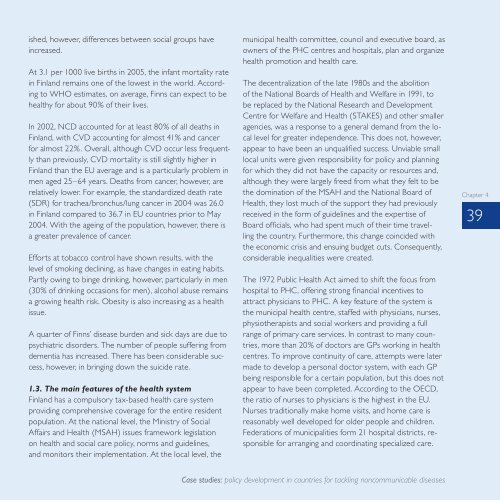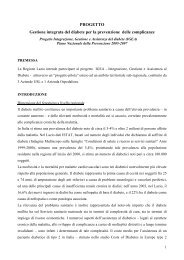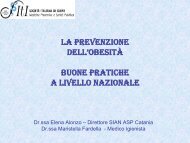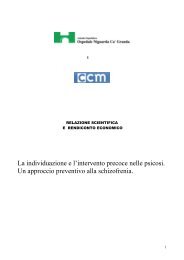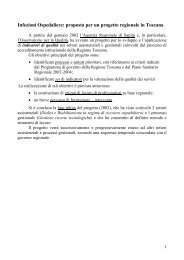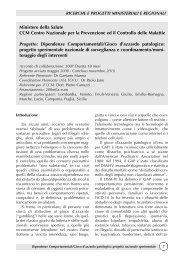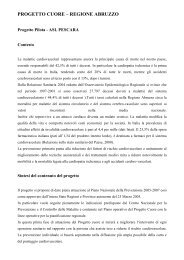Gaining health : analysis of policy development in European ...
Gaining health : analysis of policy development in European ...
Gaining health : analysis of policy development in European ...
You also want an ePaper? Increase the reach of your titles
YUMPU automatically turns print PDFs into web optimized ePapers that Google loves.
ished, however, differences between social groups have<br />
<strong>in</strong>creased.<br />
At 3.1 per 1000 live births <strong>in</strong> 2005, the <strong>in</strong>fant mortality rate<br />
<strong>in</strong> F<strong>in</strong>land rema<strong>in</strong>s one <strong>of</strong> the lowest <strong>in</strong> the world. Accord<strong>in</strong>g<br />
to WHO estimates, on average, F<strong>in</strong>ns can expect to be<br />
<strong>health</strong>y for about 90% <strong>of</strong> their lives.<br />
In 2002, NCD accounted for at least 80% <strong>of</strong> all deaths <strong>in</strong><br />
F<strong>in</strong>land, with CVD account<strong>in</strong>g for almost 41% and cancer<br />
for almost 22%. Overall, although CVD occur less frequently<br />
than previously, CVD mortality is still slightly higher <strong>in</strong><br />
F<strong>in</strong>land than the EU average and is a particularly problem <strong>in</strong><br />
men aged 25–64 years. Deaths from cancer, however, are<br />
relatively lower. For example, the standardized death rate<br />
(SDR) for trachea/bronchus/lung cancer <strong>in</strong> 2004 was 26.0<br />
<strong>in</strong> F<strong>in</strong>land compared to 36.7 <strong>in</strong> EU countries prior to May<br />
2004. With the age<strong>in</strong>g <strong>of</strong> the population, however, there is<br />
a greater prevalence <strong>of</strong> cancer.<br />
Efforts at tobacco control have shown results, with the<br />
level <strong>of</strong> smok<strong>in</strong>g decl<strong>in</strong><strong>in</strong>g, as have changes <strong>in</strong> eat<strong>in</strong>g habits.<br />
Partly ow<strong>in</strong>g to b<strong>in</strong>ge dr<strong>in</strong>k<strong>in</strong>g, however, particularly <strong>in</strong> men<br />
(30% <strong>of</strong> dr<strong>in</strong>k<strong>in</strong>g occasions for men), alcohol abuse rema<strong>in</strong>s<br />
a grow<strong>in</strong>g <strong>health</strong> risk. Obesity is also <strong>in</strong>creas<strong>in</strong>g as a <strong>health</strong><br />
issue.<br />
A quarter <strong>of</strong> F<strong>in</strong>ns’ disease burden and sick days are due to<br />
psychiatric disorders. The number <strong>of</strong> people suffer<strong>in</strong>g from<br />
dementia has <strong>in</strong>creased. There has been considerable success,<br />
however, <strong>in</strong> br<strong>in</strong>g<strong>in</strong>g down the suicide rate.<br />
1.3. The ma<strong>in</strong> features <strong>of</strong> the <strong>health</strong> system<br />
F<strong>in</strong>land has a compulsory tax-based <strong>health</strong> care system<br />
provid<strong>in</strong>g comprehensive coverage for the entire resident<br />
population. At the national level, the M<strong>in</strong>istry <strong>of</strong> Social<br />
Affairs and Health (MSAH) issues framework legislation<br />
on <strong>health</strong> and social care <strong>policy</strong>, norms and guidel<strong>in</strong>es,<br />
and monitors their implementation. At the local level, the<br />
municipal <strong>health</strong> committee, council and executive board, as<br />
owners <strong>of</strong> the PHC centres and hospitals, plan and organize<br />
<strong>health</strong> promotion and <strong>health</strong> care.<br />
The decentralization <strong>of</strong> the late 1980s and the abolition<br />
<strong>of</strong> the National Boards <strong>of</strong> Health and Welfare <strong>in</strong> 1991, to<br />
be replaced by the National Research and Development<br />
Centre for Welfare and Health (STAKES) and other smaller<br />
agencies, was a response to a general demand from the local<br />
level for greater <strong>in</strong>dependence. This does not, however,<br />
appear to have been an unqualified success. Unviable small<br />
local units were given responsibility for <strong>policy</strong> and plann<strong>in</strong>g<br />
for which they did not have the capacity or resources and,<br />
although they were largely freed from what they felt to be<br />
the dom<strong>in</strong>ation <strong>of</strong> the MSAH and the National Board <strong>of</strong><br />
Health, they lost much <strong>of</strong> the support they had previously<br />
received <strong>in</strong> the form <strong>of</strong> guidel<strong>in</strong>es and the expertise <strong>of</strong><br />
Board <strong>of</strong>ficials, who had spent much <strong>of</strong> their time travell<strong>in</strong>g<br />
the country. Furthermore, this change co<strong>in</strong>cided with<br />
the economic crisis and ensu<strong>in</strong>g budget cuts. Consequently,<br />
considerable <strong>in</strong>equalities were created.<br />
The 1972 Public Health Act aimed to shift the focus from<br />
hospital to PHC, <strong>of</strong>fer<strong>in</strong>g strong f<strong>in</strong>ancial <strong>in</strong>centives to<br />
attract physicians to PHC. A key feature <strong>of</strong> the system is<br />
the municipal <strong>health</strong> centre, staffed with physicians, nurses,<br />
physiotherapists and social workers and provid<strong>in</strong>g a full<br />
range <strong>of</strong> primary care services. In contrast to many countries,<br />
more than 20% <strong>of</strong> doctors are GPs work<strong>in</strong>g <strong>in</strong> <strong>health</strong><br />
centres. To improve cont<strong>in</strong>uity <strong>of</strong> care, attempts were later<br />
made to develop a personal doctor system, with each GP<br />
be<strong>in</strong>g responsible for a certa<strong>in</strong> population, but this does not<br />
appear to have been completed. Accord<strong>in</strong>g to the OECD,<br />
the ratio <strong>of</strong> nurses to physicians is the highest <strong>in</strong> the EU.<br />
Nurses traditionally make home visits, and home care is<br />
reasonably well developed for older people and children.<br />
Federations <strong>of</strong> municipalities form 21 hospital districts, responsible<br />
for arrang<strong>in</strong>g and coord<strong>in</strong>at<strong>in</strong>g specialized care.<br />
Chapter 4<br />
39<br />
Case studies: <strong>policy</strong> <strong>development</strong> <strong>in</strong> countries for tackl<strong>in</strong>g noncommunicable diseases


